

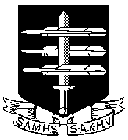 The South African
The South African
Published on the Website of the South African Military History Society in the interest of research into military history
When you go home,
tell them of us and say
“That for your tomorrow,
we gave our today.”
Epitaph in the Cemetery
on the Battlefield of Kohima,
Burma, April 1944
J. M. Edmonds
In the Beginning
It often surprises me to discover how little South Africans in general know about our participation in the Second World War. On Quora, some Americans ask whether we fought on the German side.
The Second World War came into my consciousness when I was six years old. On 3rd September, 1939, we were about to sit down to lunch when my parents and sister – eleven years my senior – switched on or our Phillips wireless – and became silent. I began to chatter when a thin, reedy voice came out of the loudspeaker and my sister said irritably “Keep quiet!
The voice, I later discovered, was that of Neville Chamberlain, Britain’s Prime Minister.
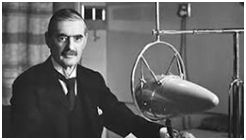
(British) Prime Minister
Neville Chamberlain, 3rd September, 1939
He was telling the world that Britain and Germany were at war, as the German government had ignored the British and French demand that the German army withdraw its forces from Poland, invaded at dawn on 1st September.
The family remained silent after he had spoken, though my mother, whose late father was a German, began to voice her concern about her niece, Hedda, in Germany.
On Monday, 4th September, the Prime Minister, General J.B.M. Hertzog, proposed to Parliament that the Union of South Africa should remain neutral. He said Germany was only righting the wrongs of the 1919 Treaty of Versailles. He clearly did not know of the the equally harsh treaties Germany had imposed on France in May, 1871, and on Russia in March, 1918. Nor did he consider the enormous destruction Germany had wrought in Belgium and France‘s industrial and mining areas and towns since August, 1914 – and which was being repeated in Poland as he spoke in 1939.
The Premier seemed to speak sympathetically of Adolf Hitler in spite of the series of broken agreements and aggressive actions by Hitler, as President-Chancellor or Fuehrer of Germany, starting with the Wehrmacht’s occupation of the de-militarised Rhineland, in March, 1936.(1)
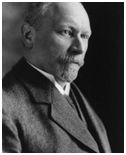
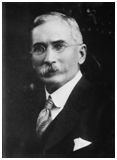
Gen. JC Smuts Gen. JBM Hertzog
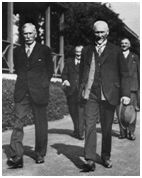
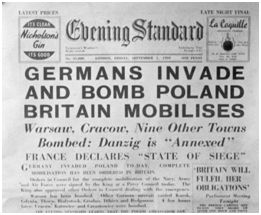
Deputy Premier J.C. Smuts, disagreed. He declared that Hitler wanted to dominate the world and would demand the return of former German colonies, including South-West Africa, which the Union administered as a mandated territory on behalf of the League of Nations. Smuts considered that war against Germany was in the interests of South Africa. He warned that not entering the war with Britain, France and the Commonwealth could lead to the Union’s isolation and a hostile international environment. Smuts’s proposal that the Union declare war on Germany was adopted by Parliament by 80 to 67 votes and he became Prime Minister.
The Sense of War
We lived in Sabie, a village in the Eastern Transvaal (Mpumalanga), and the War hardly made any visible impact at first. Most visible in Sabie was the local company of an Active Citizen Force unit, the Regiment Botha, who spent evenings training on the school’s rugby field. They increased their parades to more than once per week.
Gradually, young men of the town began disappearing and we would hear that they had ‘joined up.’ They included some of the junior staff in my father’s government office, some shop assistants and other men. Several of our relatives began ‘joining up’.
One morning, after the mid-morning break, our Grade 2 teacher, who came from Britain, returned to our classroom and stood at the window in tears. We heard later that she and the Dr Kat, the Headmaster, who came from Holland, had listened to the radio during break. They had heard of the Wehrmacht’s over-running France and encircling the British Expeditionary Force.
On another day, in 1940, the Headmaster’s brother, Lieutenant I.M.L. Kat-Ferreira, arrived at our school in an armoured car. He invited the pupils to look at it and even allowed us to climb inside. Years later I discovered that it was a South African made Marmon-Herrington, Mark 1 prototype being driven on the rough country roads in the surrounding hills to assess its endurance. Its armour-plating was made by Iscor and it was assembled by Dorman Long, but the chassis and its four-wheel drive and machine-gun were imported from Canada and America.
Its first use was in operations against Italian forces in East Africa. Six Marks were eventually developed. Only two eight-wheeled Mark VI prototype cars were built. The Mk IV was still used for training until the 1960s. As fortunes changed later in the War, the UDF was able to obtain, inter alia, American Sherman tanks for the Italian Campaign (1943-1945).
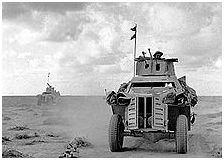
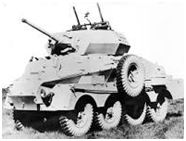
Marmon–Herrington armoured car
Marmon-Herrington Mk VI
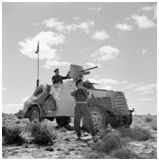
One afternoon an official envelope addressed to my father and marked IDVSM/OHMS arrived from the Department of Defence. Puzzled, my Mother opened it and found that my father had secretly volunteered to serve in the Defence Force though he was fifty years old. Fortunately, I suppose, his offer was rejected because of his age, his rank in the Civil Service and the importance to war industries of the Department of Mines, in which he served. The letter told him that he was, however, enrolled as a member of the National Reserve and enclosed bronze buttonhole badge embossed with the letters ‘NS’.(2)
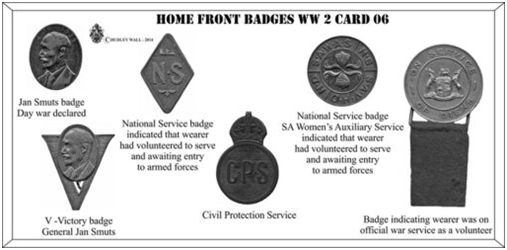
Various badges worn by civilians in the War
My father was a quiet man who did not believe that a Civil Servant should advertise his political opinions. He only explained his motives to me after he retired and I was a student in ‘Political Science’ at university and had myself read Mein Kampf, Adolf Hitler’s pseudo-autobiography, in which he explained his aims for Eastern Europe. My father was influenced mainly by reading politicians’ contradictory speeches.
His reading of the speeches persuaded him that Smuts had a far better understanding of and insight into Adolf Hitler’s intentions and conduct than had General J.B.M. Hertzog and Dr D.F. Malan, Leader of the Opposition in 1940. They, like Chamberlain and his supporters, had readily accepted Hitler’s false explanations, excuses and promises.
Gaining Strength
South Africa was unprepared for War. The Union had only sixteen artillery batteries with only eighty-seven guns and three 3-inch mortars, and a mere eight anti-aircraft guns. Ammunition was very scarce for all artillery, with a mere 28 941 rounds of field-artillery ammunition – insufficient for more than a few hours engagement.(3)
In 1939 the SA Air Force had only 173 officers and 1,664 other ranks, one operational and two training squadrons. On 6th September, 1939, the SAAF's front-line operational aircraft consisted of four Hurricanes Mk1 (a fifth having crashed), a twin-engine Blenheim bomber and a single-engine Fairey Battle bomber. It also possessed 63 obsolete Hawker Hartbeeste, six obsolete Furies, three DH 66 Hercules, one Gloster AS 31, and a few equally obsolete Avro Tutors, Westland Wapitis, Hawker Harts, Envoys and Audaxes.(4)
The 1912 SA Defence Act was vague about where Soth African soldiers were allowed to serve in operations. Consequently, the government needed to rely on volunteers to fight outside South Africa. The volunteers were distinguished by an orange tab that slipped onto their epaulets. Later, volunteers to serve outside Africa also wore the orange tab. The tabs were worn until after Gen. Smuts’s funeral on 15th September, 1950.
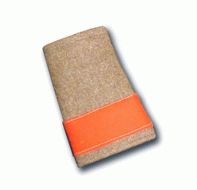
Orange epaulette tab
In 1939 the Army Active Citizen Force consisted of only 14 631 part-time service men while the professional Permanent Force amounted to merely 3 353. By the end of the War the total of the UDF numbered 406 133. They were not only White men but also Black, Indian and Coloured servicemen, whose non-combatant services had been irreplaceable. Another 63 341 were in the part-time home guard called the National Reserve Volunteers, in addition to 24 975 women of the Women’s Auxiliary Army Services, Women’s Auxiliary Air Force, SA Women’s Auxiliary Naval Service, and the SA Military Nursing Service. Some 77 239 Black South Africans served in the Union Defence Force in support roles.

Indian & Malay Corps badge

Native Military Corps badge
The SA Naval Forces served with 95 armed trawlers and whale catchers as corvettes and mine sweepers in the South Atlantic, Indian Ocean and the Mediterranean. More than 20 000 SANF officers and ratings were seconded to the Royal Navy for service in South East Asia.
The SA Air Force grew to thirty-five squadrons flying 82 401 operational missions in Abyssinia, the Western Desert, Tunisia, Italy, the Warsaw Uprising, and in maritime operations.(5)
The Japanese Fright
The rapid conquest of South East Asia by Japanese forces in late 1941 aroused concern all over the Indian Ocean. In 1942, Durban’s beaches were defended with barbed wire entanglements with only narrow gaps to admit the holiday makers. At various points along the coast there were Radar stations and concrete ‘pill-boxes.’ They were concrete emplacements with horizontal slits in their walls to allow protected machine guns to traverse left and right to sweep the beaches with gun-fire in case Japanese soldiers landed from the sea.
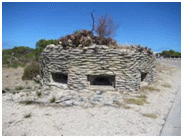
Pill-Box
The Union’s Coastal Defence Staff was completely surprised when early in 1942 an aircraft carried by I-10 Yokosuka, a Japanese submarine, flew reconnaissance flights at night and at dawn over Durban, East London, Port Elizabeth and Simonstown. It was now realised that a brightly lit city would reveal the silhouettes of ships in the convoys moored off shore.(6) As it happened, German, Japanese and Italian submarines sank almost 800 000 tons of shipping within 1,000 miles of our ports.
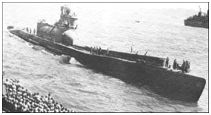
Japanese sub with deck hangar
ARP men on patrol frequently were heard shouting “Put out that light” at inland visitors in hotels when they were unaware of the blackouts.
Convoys passing South Africa consisted of merchant ships, sailing in large groups protected by destroyers and frigates. Their cargo could be aircraft, tanks, other military vehicles, ammunition, fuel, food, medicines, other essential supplies as well as military personnel carried to Egypt, India, or to Britain and the USA and other countries involved in the War.
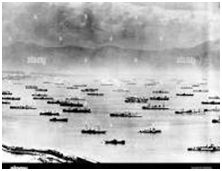
A Convoy at Sea
War Industries
Though she was at war, South Africa could not rely on importing armaments and military equipment. Seven European countries – France, Poland, Netherlands, Belgium, Denmark, Norway and Luxembourg - had been occupied by German forces and, anyway, Europe was also unprepared for a large war and would not have spared the limited armaments they had.
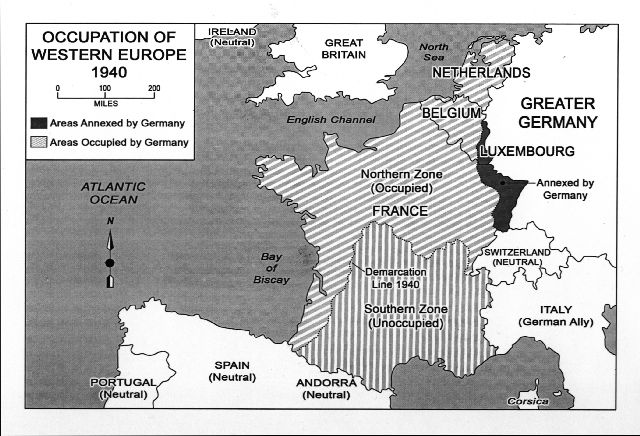
Consequently, having depended mainly on mining and agriculture to sustain her economy, South Africa now had to develop secondary industries to provide armaments.
Secondary industries had to be developed from the ground up to provide everything needed. The government appointed the brilliant Dr H.J. van der Bijl, founder of Iscor, as Director of War Supplies to answer to the country’s military needs. Within two years our industries were manufacturing artillery (two hundred 3.7-inch howitzers), four hundred anti-tank guns and also 3-inch mortars, 32,000 military vehicles including 5,746 armoured cars, all calibres of ammunition, optical gun-sights, radios, mine detectors and tyres, shoes and boots - to mention only some of the products.
The Great Depression of 1929 – 1938 was drawing to a close and the development of the war industries helped recovery to move faster in South Africa.(7)
Britain could not supply Radar (radio detection and ranging) equipment which was essential for detecting enemy shipping along our coasts. Gen. Smuts appointed another scientific genius, Professor Basil Schonland, Director of the Bernard Price Institute for Geophysical Research at Witwatersrand University, to develop Radar for the UDF. As early as 16th December, 1939, the first signals were being reflected by the Northcliff water tower.(8)
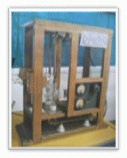
First SA Radar Transmitter
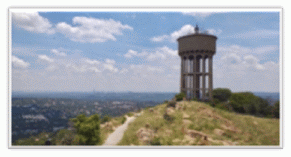
Northcliff War Tower
The Real War!
The UDF fought ‘up North’ as people called Somalia, Abyssinia (Ethiopia), Libya and Egypt (1940-1942) capturing Generalleutnant Artur Schmitt with his Division in Bardia.
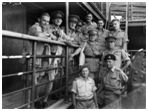
Aboard Ship on their way ‘Up North’
The 5th SA Infantry Brigade was almost wiped out by the German 15th Panzer and Italian Ariete Divisions in the battle of Sidi Rezegh. The GOC of 2nd SA Infantry Division, trapped in Tobruk, surrendered to avoid heavy losses at the hands of Gen Erwin Rommel. Losses in the Western Desert included killed and died of disease. POW taken at Tobruk numbered 10,772. In October, 1942, however, the 1st SA Division fought successfully in the second battle of El Alamein.
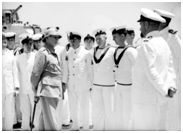
Smuts Visiting SANF
seconded to RN in Egypt
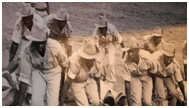
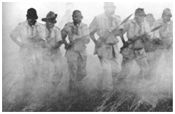
NMC Soldiers in the Field Only for Guards Armed for War


Cpl Lucas Majozi earned the Distinguished Conduct Medal
rescuing wounded during the Battle of El Alamein
(L) Photograph and (R) Portrait by war artist Neville Lewis
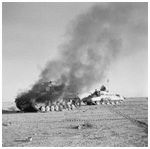
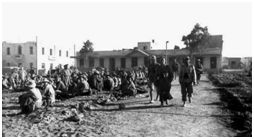
Op Crusader Rommel inspects Tobruk POW

SA Memorial, El Alamein
Meanwhile, in May 1942 Gen. Smuts, concerned at the Japanese presence in the Indian Ocean, sent the 7th SA Infantry Brigade to participate in the Allied capture of Madagascar.
The 6th SA Armoured Division then took part in liberating Italy from 1943 to 1945, fighting from the heel of Italy to the Po Valley.
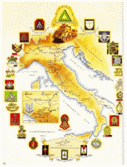
Map of Italy
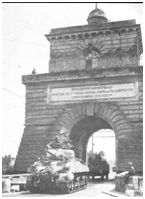
6th SA Armoured Division SA Tanks Cross the Tiber, Rome
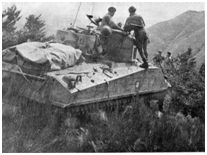
Monte Albano, NW of Florence – Chianti Hills.
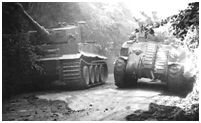
Sherman Tank passes abandoned German Tiger Tank
Evacuees in SA
Holidaying in Durban in July, 1942, we were surprised to find the top floor in the hotel occupied entirely by British children. They had been evacuated from Britain to avoid the bombing of cities by German aircraft. Most went to rural villages but 2,664 were evacuated to Canada, Australia and New Zealand, and 353 came to South Africa.
In 1942, many South African parents gave their sons Army uniforms like the little boy in the photo. I received this on my ninth birthday. The tailor stitched a First World War ribbon on to the jacket causing a lot of mirth to soldiers.

The Author and his sister, 1942
Rationing
Within a year of the start of the War certain foodstuffs became scarce because of unusually small crop yields. It was also because essential foods needed to be exported to our armed forces in East and North Africa and also to be sold in Britain.
South Africa’s agricultural economy suffered considerable financial loss from the British decision not to import our deciduous and citrus fruits so as to leave shipping space for meat and dairy products from Australia and New Zealand.
Rationing was inevitable, though it was never as drastic as in Britain and in occupied Europe, where people starved. Germany had commenced rationing almost as soon as the War began. Large quantities of canned vegetables, fruit, meat and jam, as well as rock-hard army biscuits called ‘hardtack,’ were produced for Allied forces in the various operational theatres of war.(9)
The War Measures Act of 1940 gave the government powers to control supplies and prices, and to prevent hoarding and profiteeringfrom foodstuffs and other scarce essential goods.
Petrol was controlled early. Ships bringing fuel and armaments to South Africa were particular targets for attacks by enemy raiders – usually disguised armed merchant vessels armed with six 15-cm (5.9-inch) guns and torpedo launchers - and by submarines. The cruiser Admiral Graf Spee won infamy in the South Atlantic but was scuttled after being severely damaged when confronted by three British cruisers. To lessen dependence on imported fuel oil, petrol coupons were issued to limit its use. Quite frequently drivers were prosecuted for illicit petrol consumption.(10)
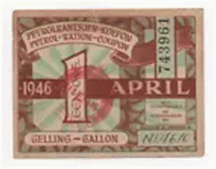

Examples of Petrol Coupons
Fortunately, there were two commodities available in the Union, to ease petrol shortages.(11)
One was an additive called‘Satmar’ which was made using torbanite, an oil shale, used to manufacture petrol and sold for about 20% of the ordinary petrol price. The company, Anglovaal, discovered torbanite near Ermelo and in 1934 established the South African Torbanite Mining and Refining Company to produce petrol. Satmar pumps were everywhere.
The other local fuel called ‘Union’ was Union motor spirit, made as far back as 1917, by the Natal Cane By-Products Ltd. It was usually used mixed with petrol. Sugarcane ethanol was an alcohol-based renewable fuel produced by the fermentation of sugarcane extract.
South Africans were not very disciplined about rationing or saving scarce resources. For some people this was a political gesture. It was also because we were so far from the theatres of war and serious deficiencies and did not realise how serious rationing was needed.
From being a maize exporter South Africa had to import maize and wheat from Argentina and Australia. These were rationed in 1941 and 1942 because of heavy unseasonal rains in the Cape and droughts elsewhere in the country which also affected cultivation of sugar cane and potatoes. Despite measures to ease shortages the arrival of 67,000 Italian prisoners of war as well as Allied shipping in our ports raised the demand for foodstuffs.(12)
In December, 1942, regulations were published, ordering that only un-sifted flour could be produced and sold. It did not take long, however, for people to make sieves which provided white flour for white bread and cake.
Further, bread was not to be delivered on Wednesdays, and the public was also required not to eat meat on Wednesdays. Once again, many ignored these rules.
To save paper and to publicize the activities of the UDF, the Postmaster-General introduced miniature stamps – nicknamed ‘bantams.’ The stamp designs were paintings by Neville Lewis, an official War Artist, who also accompanied the forcs into the theatres of War.
The stamps featured
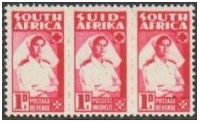
Elizabeth Liebenberg of the Woman’s Auxiliary Army Corps,
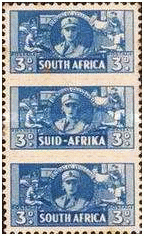
Leading Signalman C.E. Peter, SANF,

a welder,

a tank,

an Army Signalman

and marching soldiers.

The pilot was Lieutenant Bob Kershaw, who earned the Distinguished Service Order for courageously rescuing Capt Jack Frost who had crashed in enemy-held territory in Abyssinia.(13)
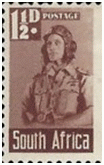
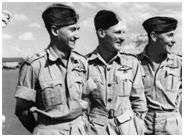 Capt Jack Frost, Lt RHC Bob Kershaw and Capt S van Breda Theron
Capt Jack Frost, Lt RHC Bob Kershaw and Capt S van Breda Theron
More to See
My father was transferred in April, 1940, to Lichtenburg in the western Transvaal, 250 km from Pretoria. Here the UDF was more visible. Convoys of three-ton trucks passed through the town often – perhaps en route to Potchefstroom. If they passed down the main street during our school’s morning break, we rushed to the fence to look at them. Often, the soldiers flung thick rock hard ‘army’ biscuits at us – and we kept them as souvenirs.
General Koos de la Rey’s daughter called ‘Tant Polly’ lived on the General’s farm outside the town. She was Honorary Colonel of Regiment de la Rey, often wearing uniform. She used to feed the passing soldiers when they stopped in the town overnight. Huge marquee tents were erected to serve as dining rooms and sleeping quarters. My mother served in the SA Women’s Auxiliary Service, a part-time voluntary unit intended to help maintain servicemen’s morale, feed them and to care for the families whose fathers and husbands were away on active service. So Mom was called upon to help feed the soldiers. My father lent a hand and I would be taken along. It was a thrill to be among all the uniformed men.
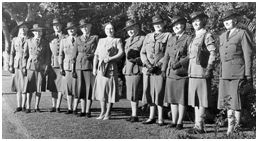
SAWAS with Queen Elizabeth in 1947
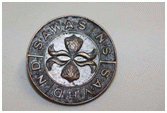
SAWAS Badge
One morning the school Principal gathered us all together in front of the school to tell us that a former pupil, Salman Datt had been killed in action. We stood for some minutes in silence with our heads bowed. Salman’s name appears on a memorial at the War Museum in Johannesburg.
Real Excitement
My father’s next transfer, in August, 1942, was to the Mines Department office in Pietersburg, a 40,000 square-mile mining area. It opened a new door to thrills. Only about two miles out of town was 26th Air School. Run by the SAAF and the Royal Air Force jointly, as a unit of the Commonwealth Joint Air Training Scheme, and commanded by Colonel H.J. Marttin, CBE, DFC. Here British and South African and some European men – such as Yugoslav Prince Alexander - were trained to fly. Planes flew overhead all day - Oxford Airspeed AS training aircraft – all painted yellow.
Uniformed men were seen everywhere in town. There may have been casualties during training, but the only one I knew of was on a koppie beside the road south of Pietersburg, upon which a wrecked Oxford lay.
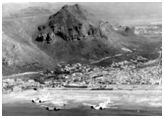
Oxfords over Muizenberg
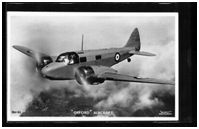
An Oxford Airspeed
Surprisingly, Italian Prisoners of War also roamed in town, clad in a grey uniform.(14) Only the dyed-in-the-wool Fascist soldiers were confined in a segregated block in the Zonderwater POW camp, near Cullinan. Many Italians worked and lived on farms dispersed around Pietersburg and elsewhere. Though they were forbidden to enter bars and cinemas, no one stopped them – not even the Military Policemen patrolling the town. In accordance with the Convention Relative to the Treatment of Prisoners of War, Geneva, 1929, they were paid for working on farms and elsewhere. Traces of work they did then may still be seen now on some farms (and indeed all over South Africa, such as Tom Jenkins Drive in Rietfontein, Pretoria.) Many chose to remain in the Union after Italy left the Axis.
Lacking sufficient preparation for POW, the administration of POW camps was at first rather disastrous. After the initial debacle, Colonel H.F. Prinsloo was sent to command Zonderwater. He combined discipline mixed with sincere sympathy for the imprisoned men. To keep them beneficially occupied he enabled them to establish an orchestra, a library, craft exhibitions and to have art classes and to sports and educational facilities - enabling 4,000 to learn to read. He encouraged them to work outside the camp as labourers, builders, cooks, gardeners, mechanics and other jobs. His devotion to duty earned him the Order of the British Empire decoration (OBE), the Italian government awarded him the Order of the Star of Italian Solidarity and the Pope awarded him the Ordine di Bene Merente. In the First World War he had earned the French Croix de Guerre.
Wartime Films and Music
The bioscopes – as we called movie theatres then – made us all aware of the War – local newsreels were African Mirror and Nuus van Orals – as well as British newsreels, Movietone and Pathé - showed events in Poland, France, Britain, and in South Africa. Newsreels in 1940 showed refugees fleeing along French roads as German aircraft bombed and machine-gunned them. The Union Defence Force’s operations in Italian ruled East Africa, the Western Desert and Italy and eventually, the British and American landings on the shores of Normandy were also shown.
Feature films portrayed events in the War, such as Waterloo Bridge with the actors Robert Taylor and Vivien Leigh and U-Boat 29, a British film with Conrad Veidt as a U-Boat captain sent on an intelligence gathering mission to Scapa Flow where the British fleet was moored.
Other memorable films were Dangerous Moonlight with The ‘Warsaw Concerto’ as the theme music, Casablanca, The First of the Few, Commandos Strike at Dawn, The Lion has Wings and The Fighting 69th about a New York infantry regiment in the First World War; Leslie Howard’s The 49th Parallel, Charlie Chaplin’s The Great Dictator, and the film about servicemen being entertained Stage Door Canteen, with a wide range of 82 performer – actors, musicians and comedians.

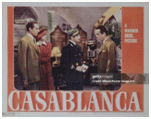


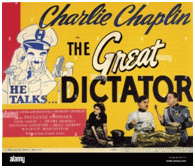

In Pietersburg reception of SABC broadcasts was blocked by a range of hills, the Ysterberge. So I learnt to listen to the BBC. It gave access to all kinds of events – even accounts of D-Day and Richard Dimbleby’s description of the horrors of Bergen-Belsen concentration camp where 70 000 people were murdered. Regrettably, when members of the Opposition in Parliament were offered a trip to see the camps, they declined to go.
The BBC opened a door to my education since I could listen to a wide range of events, discussions and radio drama.
There were also wartime films and music that were often meant to build morale or promote propaganda.
The popular music included ‘So Long Sarie’, ‘My Sarie Marais’, ‘The Warsaw Concerto’, GlennMiller’s ‘In the Mood’, the Andrew’s Sisters’ songs, including ‘Boogie Woogie Bugle Boy’, Vera Lynn’s ‘The White Cliffs of Dover’,‘We’ll Meet Again’ and ‘I’ll Be Seeing You’, Gracie Fields’s ‘Wish me Luck as You Wave Me Goodbye’, and ‘When The Lights Go On Again (All Over The World)’, and of course, the popular German song ‘Lili Marlene’.
There were also comic songs like ‘Kiss me Goodnight, Sergeant Major’, ‘Run, Rabbit’, ‘We're Going to Hang Out the Washing on the Siegfried Line’, ‘This is the Army, Mr Jones’, ‘Bless ‘em All,’ and ‘The Quartermaster’s Stores.’ One even heard songs from the First World War - ‘Keep the Home Fires Burning’ and ‘It’s a Long Way to Tipperary’.
Noel Coward visited South Africa in 1944 on the suggestion of ‘Ouma’ Smuts, wife of the Prime Minister, to benefit her war charities. Coward arrived in Pretoria in February 1944 and performed for the UDF Entertainment Unit and then performed while touring the Union. His play Blithe Spirit was performed at the Opera House in Pretoria in July before going on a countrywide tour. The HNP MP Paul Sauer made unfriendly remarks about the actor-playwright’s visit saying “ Have we lost our balance to such an extent that we make heroes of film actors and music-hall luminaries at the state expense?”
Enemies at Home
While so many South Africans voluntarily enlisted in the UDF to participate in the War against Nazi Germany and Fascist Italy, there were also, as there were in some European countries, those who joined movements that shared Nazi values.
In occupied Europe they included the Nationaal-Socialistische Beweging in the Netherlands, the Nasjonal Samling in Norway and in Britain there was the British Union of Fascists. All the proto-Nazia and Fascist organizations used violence to advance their interests and supported the German dictatorship. Their beliefs and conduct led to friction with their own governments and compatriots who opposed Fascism and Naziism.
The surname of the fascist leader, Vidkun Quisling, became a synonym for ‘traitor’ in Europe. However, Norwegians organized a strong, determined resistance movement, Motstandsbevegelsen, that undertook sabotage, assassinations other forms of armed and passive resistance- resisting contact with German soldiers. In 1994, they destroyed the heavy water plant in Telemark, Norway, and sank the ship carrying remaining heavy water to Germany, so terminating the German nuclear weapons programme.
The Would-Be Fuehrers
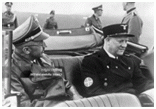
Quisling & Himmler - Norway
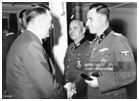
Leon Degrelle – Belgium
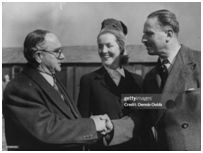
Pirow meets leader of British Union of Fascists
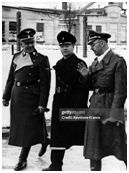
Anton Musser & and Himmler - Netherlands
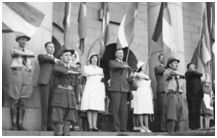
The OB Salute

OB Emblem and Dr Hans van Rensburg
In South Africa there were the South African Gentile National Socialist Movement or Gryshemde, Oswald Pirow's proto-fascist Nuwe Orde, and the Ossewa Brandwag whose terrorist wing, the Stormjaers, sabotaged bridges, railways, power lines, post-offices and assaulted solitary soldiers. Many members were motivated by anti-British sentiments rather than by Nazi National Socialism. Not understanding the reasons for the War they regarded it as resulting from ‘British imperialism.’ They believed that if Germany won, Hitler would help them to establish an Afrikaner republic in South Africa, unaware that in peace overtures to Britain he promised that Britain would retain all the countries constituting the ‘empire,’ as he called the ‘Commonwealth.’
My sister, while training to be a teacher in Johannesburg, joined the Civilian Protection Service. They provided first aid to civilians injured in emergencies. Almost 80 000 civilians served in the CPS.(15) The sole ‘emergency’ Marie experienced was the fighting between soldiers and Stormjaers on the evenings of 31st January and 1st February, 1941. Starting at the Johannesburg City Hall the fighting spread to the offices of Die Transvaler and Die Vaderland. The Stormjaers armed themselves with sticks, bicycle chains, lengths of metal pipe and knives while the soldiers used their fists and boots.
Countering German Propaganda
In 1940, Gen Smuts appointed Dr Ernst Malherbe, a renowned academic, as Director of Military Intelligence.A group of academics persuaded Gen. Smuts to set up, under Malherbe, a group of information officers to explain to the armed forces why South Africa was at war. Eventually, almost every unit had an Information Officer. They were important in rebutting the broadcasts from Radio Zeesen in Germany and propagandists in the Union.
Liberty Cavalcade and the Steel Commando
Rebutting the Zeesen broadcasts, to encourage recruiting, to build morale and to raise funds, had become necessary. Colonel Malherbe’s team organised a travelling military exhibition called the Steel Commando, to visit rural towns, as well as the Air Commando and the War Train.
The Steel Commando travelled in a variety of military vehicles, one of which was fitted out as a recruiting office. The SAAF’s Air Commando demonstrated flying and dropped recruiting pamphlets.
In Lichtenburg, as elsewhere,the Commando provided exhibits of arms, uniform and equipment – and performed military demonstrations. A retreat parade was held at the municipal sports ground where the salute was taken by Col. G.J. Greeff, a veteran of the Anglo-Boer War and of the Great War. He was accompanied by the Honorary Colonel of Regiment de la Rey, Col J. E. (Pollie) de la Rey-Morkel.
In some towns a number of mounted Oudstyders (veterans of the Boer commandos of 1899-1902), escorted the Steel Commando.
The mobile tours served the purpose of bringing the public closer to South Africa's servicemen and to generate a sense of national pride.
The Liberty Cavalcade was an immense exhibition, arranged by Johannesburg’ City Council at Zoo Lake in May and June, 1942. Its object was to raise funds for various wartime needs, such as the National War Fund, and also to attract recruits to the UDF.(16)
It consisted of military and cultural exhibits illustrating Allied countries as well as amusement entertainments. It drew more than 50 000 visitors.
Its success prompted Cavalcade exhibitions to be held in Port Elizabeth in 1943, Cape Town, Durban and Pietermaritzburg in 1944.
The War Train was an SA Railways and Harbours version of the Steel Commando. It carried a variety of SA-made armoured cars and artillery and resembled the armoured trains the UDF possessed before the War.
Military Hospitals
After they graduated from college, my sister Marie, and several of her class-mates were recruited to the SA Medical Corps as dieticians. They were dispersed to the numerous military hospitals established in various centres in South Africa.
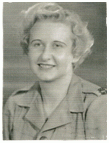
Private Marie Fourie, AXMC
Marie was sent to Springfield Military Hospital, in Durban. It was a period when the Allies’ ships were at high risk of being attacked by enemy planes in the Mediterranean. Thus ships carrying wounded and sick soldiers from the Middle East and Asian theatres took the Cape route to reach Britin, the USA and even Australia. When we visited my sister, the hospitals was treating many soldiers in transit. Several other hospitals - the ‘Oribi’ in Pietermaritzburg, and ‘Baragwanath’ in Johannesburg were used for Commonwealth and Allied soldiers, sailors and airmen.
The End of the War in Europe
Since the Western Allies landing on the Normandy beaches in June, 1944, the German Wehrmacht’s fate had been sealed by them and by the Russian forces from the east. From January, 1945, it was clear that Germany would soon be defeated.
Ultimately, on 30th April, with Russian soldiers only a few streets away from his hideout, deep beneath the ruined Reichs Chancellery in shattered Berlin, Hitler shot himself. Some days later his successor, Gross Admiral Doenitz surrendered, ending the rule of Germany by a murderous criminal gang that had defrauded, plundered and intimidated the German nation and occupied Europe.(17)
Another speech on the radio announced the end of the War. It was by the British Prime Minister, Winston Churchill. His voice had used words to provide powerful leadership from May, 1940. It was the voice that, despite the opposition of appeasers, had warned against Hitler’s ambitions from 1933, only for Chamberlain to write “The real danger to this country is Winston. He is the warmonger, not Hitler.” But Churchill was decisively right.
Hitler gave evidence of the danger he represented when sending the Wehrmacht into the Rhineland in 1936, annexing Austria in 1938, invading Czechoslovakia in 1938 and by invading Poland on 1st September, 1939. Churchill’s inspiring speeches ultimately led the Commonwealth and the Allies to victory.
On 8th May, 1945, Churchill, spoke at 3p.m. This time we were not hunched over the wireless but standing in a crowd in front of the Pietersburg Town Hall where loudspeakers enabled all to hear his announcement, broadcast by the BBC Radio.
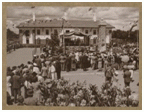
A similar gathering at
Pietersburg Townhall 8th May, 1945
The German war is therefore at an end.”
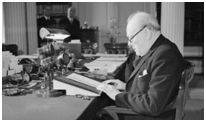
Winston’s announcement on 8th May 1945
For South Africans the War also ended. Yet, when the Government asked for volunteers to fight against Japan, 23 000 volunteered. However, the War with Japan ended in September, when two atomic bombs were detonated over Hiroshima and Nagasaki.
A Personal Postscript
My Mother’s German niece, Hedda-Rita, about whom she had worried, her husband Eugen and their three daughters, survived the War. A school teacher, Eugen was conscripted and sent to fight in Russia. When his unit was sent on home leave their train broke down in Poland. Wandering around, the soldiers came across a concentration camp. On arriving home in Berlin, the first thing Eugen said was “Mein Gott, Hedda, ich habe gesehen, was wir den Juden antun.”(18)

Hedda-Rita Selke
(Neé Lowenthhal)
While on leave he was ordered twice to divorce Hedda, who was half-Jewish, he refused – knowing what her and their daughters’ fate would be under Nazi laws. Arrested, he was tried by a Court Martial where he repeated his refusal. Consequently he was sentenced to be dishonourably discharged from the Wehrmacht for ‘Disgraceful Conduct.’ But his family survived - even in Hitler’s devastated thousand-year Reich.
NOTES
About the Author
Deon, while still a Major, contributed an article about the SA Corps of Marines to the first issue of the Military History Journal in December 1967. He edited an article about operation Rose - the WWII amphibious landing in Madagascar - in the June 1971 Journal.
A long gap followed until December 2010 when his speech as a Professor at the unveiling of dual memorials to both sides (Boer and Brit) at Surprise Hill, part of the Siege of Ladysmith in the Anglo-Boer War, was reported in the Journal. Deon proposed the toast to the Society in October 2016 on its 50th anniversary.
The June 2022 Journal contained his explanation of Job Masego's MM award while the December 2024 issue told of his father's Boer War memories.
He served in the Citizen Force from 1950, retiring as a Brigadier- General in 2007. He was a Professor at UNISA from 1968 to 1997.
Return to Diaries Index OR Society's Home page
South African Military History Society / scribe@samilitaryhistory.org